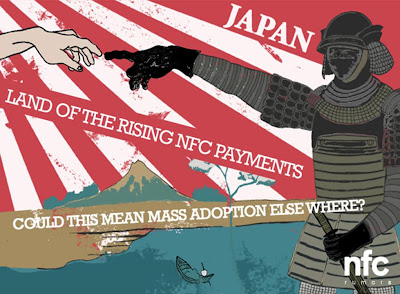What is NFC?
Wikipedia: Near field communication, or NFC, allows for simplified transactions, data exchange, and connections with a touch.
 |
| How NFC works. |
If it’s something like the Bluetooth technology, then WHAT’S THE DIFFERENCE?
Bluetooth | NFC |
· Needs pairing. | · Doesn’t require pairing. |
· Consumes more energy. | · Consumes lesser energy. |
· Longer range (up to 10 meters) | · Short range (4cm – which means it’s safer) |
· Setup time is longer (less than 6 secs) | · Setup time is shorter (less than 0.1 secs) |
FYI: It’s already adapted in Japan.
 |
| Image from nfcdata.com/blog |
In fact, McDonalds have already been doing campaigns leveraging on NFC. Read about it here in digital-examples.blogspot.com.
Subscribers download coupons from McDonald’s Japan’s website but instead of showing the coupon on the phone screen to the clerk and paying with cash, customers can place their orders, redeem their coupons and pay the tab – with their wallet phones. The customers can punch in their orders on their handsets while waiting in line.
Who’s investing on NFC?
- Google – for Android phone users.
- ISIS (a joint venture AT&T, Verizon andT-Mobile USA)
- American Express – for AMEX customers.
- Visa – to be used by multiple cards, paymentoptions and financial institution.
Nevermind global adoption, WOULD MALAYSIANS ADOPT NFC?
Yes, eventually. No doubt there would be fear of hackers, dead batteries and crashing phones but this is a similar situation when online payment was introduced. Users were first sceptical about e-transactions too but they grew to be accustomed to it. Though banks struggled a little to build consumer’s trust, some brands like AirAsia built confidence and grew stronger with e-payment. Now it’s apart of their daily lives.
Digital Dudette thinks: It might, if banks do not innovate and grow together with mobile technology.
The Experts, quoted from ComputerWeekly.com:
• In UK, the recession has dented consumer trust in banks, making mobile operators' promises of an electronic purse and e-money services even more appealing.
• Mobile payment systems created by telecommunication companies in Japan and Kenya are more successful than some joint ventures between telecos and banks.
• And with prepaid development like Vodafone: With M-Pesa, an individual would go to a kiosk, buy a pre-loaded card, enter a code into their mobile device and make transactions.
“Banks will lose customers and revenue stream.” But then again;
• Mobile operators don't realise how hard it is to develop trust in a payment brand. They have no experience.
So banks must adapt. Mobile’s the future of banking.
No comments:
Post a Comment